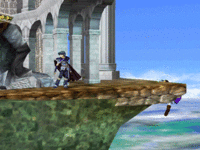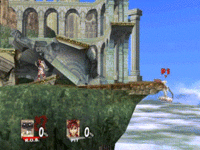Hyrule Jump: Difference between revisions
(merge proposal and a couple shifts. I feel the static picture was redundant considering we have full GIFs.) |
(Merge failed per consensus.) |
||
| Line 1: | Line 1: | ||
{{ArticleIcons|ssbm=y|ssbb=y|ssb4-u=y}} | {{ArticleIcons|ssbm=y|ssbb=y|ssb4-u=y}} | ||
[[File:SSBM Link Hyrule Jump.gif|thumb|{{SSBM|Link}} performing a Hyrule Jump in ''Melee''.]] | [[File:SSBM Link Hyrule Jump.gif|thumb|{{SSBM|Link}} performing a Hyrule Jump in ''Melee''.]] | ||
[[File:HyruleJump-Brawl.gif|thumb|{{SSBB|R.O.B.}} performing a Hyrule Jump in ''Brawl''.]] | [[File:HyruleJump-Brawl.gif|thumb|{{SSBB|R.O.B.}} performing a Hyrule Jump in ''Brawl''.]] | ||
Revision as of 19:55, August 29, 2016


The Hyrule Jump, sometimes referred to as Temple Crossing, refers to the act of performing a specialised stage jump on the Hyrule Temple stage. It is possible in all games (Super Smash Bros. Melee, Super Smash Bros. Brawl, and Super Smash Bros. for Wii U) where Temple is present.
The most well-known Hyrule Jump involves crossing the stage from its upper-right ledge to its bottom-most platform, with all characters in the games able to perform this maneuver with varying degrees of difficulty. Variants to the Hyrule Jump also exist such as the Reverse Hyrule Jump, which involves traveling the same path backwards, and other routes around the stage; these alternate routes, however, are more specialised and can only be performed by smaller pools of characters.
Temple has historically been universally banned in the competitive ruleset in all of its appearances, and the stage is almost never used, even with the Gentleman's Clause. As such, the Hyrule Jump is almost never seen in competitive gameplay.